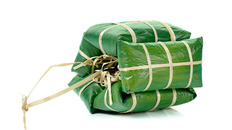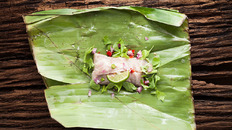Meats and Sausages
Nham
Nham is an uncooked, fermented semi-dry Thai sausage very popular in Asia. It is made from fresh lean pork, pork skins, cooked rice, fresh garlic and eye bird chillies. The sausage is wrapped in banana leaves or synthetic casings and fermented for 3-5 days (depending on the season) at about 30º C (86º F) and 50% humidity.
Rice serves not only as a value added filler but as a source of carbohydrates for lactic acid production during fermentation. Many Asian products employ rice as a fermentation source, for example “saki” - the rice wine. The fermentation is performed at high Thai ambient temperatures and there is a danger of growth of undesirable bacteria if no lactic acid is produced during the first stage of the process. For this reason glucose (dextrose) is added to jump start fermentation as cooked rice is metabolized very slowly. The pH of boiled rice is about 7.4. If stored at room temperatures (20-30º C, 68-86º F) the sausage has a shelf life of less than a week but its life can be extended by keeping it under refrigeration. Then it is served as a dish or eaten raw.
It is important to keep in mind that natural fermentations are difficult to replicate in other settings. For example, the meat mixture for Nham is traditionally wrapped in small banana leaf packets. The leaves contribute to the surface flora of the sausage, which no doubt changes the fermentation pattern.
Traditional Nham is made with Bird’s Eye Chili Peppers, which are tiny very hot chillies that can be found in Malaysia, Brunei, Indonesia, Philippines and in Thailand. Although small in size compared to other types of chili, they are very hot at 50,000 to 100,000 on the Scoville pungency scale. Tabasco and cayenne peppers are rated slightly lower at 30,000-50,000 Scoville units.
| Meats | Metric | US |
|---|---|---|
| lean pork | 700 g | 1.54 lb. |
| pork skins | 300 g | 0.66 lb. |
Ingredients per 1000g (1 kg) of meat
| salt | 23 g | 4 tsp. |
| Cure #1 | 2.5 g | ½ tsp. |
| dextrose (glucose), 1.0% | 10.0 g | 2 tsp. |
| cooked rice | 30 g | 1 oz. |
| Bird Eye Chilies or Tabasco peppers | 20 g | 0.71 oz. |
| garlic, minced 5% | 50 g | 14 cloves |
| F-LC culture | 0.24 g | use scale |
Instructions
- Trim all connective tissue and fat. Grind through a small plate (1/8-3/16”, 3-5 mm). Remove any visible fat and cook in water for about 1 1/2 hours. Cut de-fatted skin (rind) into 2-3 mm (⅛”) thick and ¾” (20 mm) long strips. Cut Bird Eye Chillies 3-5 mm thick.
- Mix meat, skins, rice and all other ingredients well together.
- Stuff tightly into air-impermeable plastic casings, about 30 mm diameter and 6-8” (15-20 cm) long.
- Ferment at 30º C (86º F) for 46 hours, high humidity. Nham is not dried, the microbiological safety of the sausage is accomplished by fermentation until the acidity in meat increases to pH 4.6.
- Refrigerate.
Notes
Cooked rice is commonly used between 2.5 and 4%.
Sausage contains a lot of garlic (5%).
Ground pepper may be added at 0.1%
Don’t replace pork skins with fat. The texture and flavor of this sausage depends largely on pork skins.
Tabasco or cayenne peppers are common everywhere.
If made traditionally (without starter culture):
- Increase salt to 3% (140 g).
- Increase fermentation temperature to 30º C (86º F).
- Ferment for 3 days at 30º C (86º F) or for 5 days if temperature is lower (> 24º C, 75º F).
Refrigerate.



















